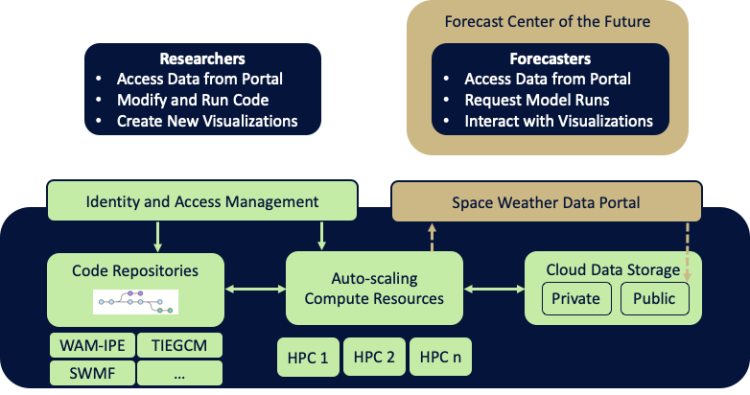SWx TREC provides technology and data solutions for the space weather (SWx) community to accelerate the research-to-operations and operations-to-research feedback process. We focus on the following key areas:
Space Weather Applications
Space Weather Data Portal
We provide public access to a next-generation public-facing Space Weather Data Portal to facilitate SWx research and education by streamlining the discovery, access, visualization, and downloading of diverse data describing SWx events. This portal is designed to lower the barriers to access and work with SWx data from myriad data providers.
Using the SWx TREC Space Weather Data Portal researchers and educators who want to easily find data to describe an event from its origin through its lifecycle can quickly find storms of interest, discover datasets that document those storms and their evolution, visualize that data to determine its relevance to their purpose, and then download it for use in their research. Researchers and educators can also save their findings or share them with others by simply capturing the URL.
H3lioViz: A tool for 3D visualization of solar wind and CMEs
One of the critical models in space weather forecasting is the Enlil solar wind prediction model that can inform space weather forecasters the direction and speed of coronal mass ejections (CMEs). The Enlil code calculates the propagation of the solar wind throughout the 3D heliosphere, but current visualization capabilities in the forecasting offices are restricted to 2D planes intersecting Earth. This limits forecasters to only be able to view CME properties that are traveling directly in the plane of the Earth.
As part of this project, the Enlil code is being committed to GitLab repositories with software workflows being created to enable deployment and execution into the Amazon Web Services (aka The Cloud). Execution of Enlil in AWS / containers is now being tested.

Space Weather Model Staging Platform
Our Space Weather Model Staging Platform, found at https://swx-trec.com, is designed to shorten the time required to bring research models, data, and visualizations into an operational environment. Such applications often take years to validate and incorporate into an operational environment, by which time they are already stale from a researcher’s perspective. Then, once the operational implementation is complete, all of the updates are incorporated and another years-long shakedown of the code is started.
To reduce the time to get codes deployed into operations, the Space Weather Model Staging Platform enables incremental research updates to be tested in an operational-like environment before sending the codes off to be used. This is accomplished by applying software engineering principles, including continuous integration and testing, to the models within the staging platform. We have a unique mix of expert software engineers that stand ready to work directly with researchers on running their code in this operational-like environment. Our platform provides elements of both testbeds and proving grounds for models, data, and visualizations.

Deep Learning Laboratory
The SWx TREC Deep Learning Laboratory (DLL) conducts cutting-edge research in the field of machine learning as applied to space weather forecasting improvement. Deep learning is a sub-field of machine learning and artificial intelligence. It uses very large neural network systems and unsupervised learning strategies to detect spatio-temporal patterns in solar, heliospheric, geospace, and ground-based space weather phenomena.
Who We Are
The SWx TREC Applications and Data team, better known at CU as MADTech (Missions, Applications, and Data Technology), comprises SWx scientists, space instrument engineers, data scientists, and software engineers working collaboratively to create new capabilities that directly improve operational SWx forecasting and nowcasting capabilities for government and commercial partners. We aim to accelerate the work of our research partners by allowing them to focus more on the science and less on accessing the tools and data needed to perform that science. Applications are implemented by and in close partnership with the Data Systems group at the Laboratory for Atmospheric and Space Physics (LASP) .


